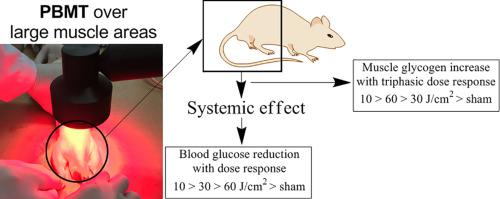当前位置:
X-MOL 学术
›
J. Photochem. Photobiol. B Biol.
›
论文详情
Our official English website, www.x-mol.net, welcomes your
feedback! (Note: you will need to create a separate account there.)
Can photobiomodulation therapy (PBMT) control blood glucose levels and alter muscle glycogen synthesis?
Journal of Photochemistry and Photobiology B: Biology ( IF 3.9 ) Pub Date : 2020-04-07 , DOI: 10.1016/j.jphotobiol.2020.111877 Kenia Mendes Rodrigues Castro 1 , Rodrigo Leal de Paiva Carvalho 2 , Geraldo Marco Rosa Junior 3 , Beatriz Antoniassi Tavares 3 , Luis Henrique Simionato 3 , Carlos Henrique Fachin Bortoluci 3 , Claudio Alberto Tellez Soto 1 , Cleber Ferraresi 1
Journal of Photochemistry and Photobiology B: Biology ( IF 3.9 ) Pub Date : 2020-04-07 , DOI: 10.1016/j.jphotobiol.2020.111877 Kenia Mendes Rodrigues Castro 1 , Rodrigo Leal de Paiva Carvalho 2 , Geraldo Marco Rosa Junior 3 , Beatriz Antoniassi Tavares 3 , Luis Henrique Simionato 3 , Carlos Henrique Fachin Bortoluci 3 , Claudio Alberto Tellez Soto 1 , Cleber Ferraresi 1
Affiliation

|
Photobiomodulation therapy (PBMT) has many effects on the energy metabolism of musculoskeletal tissue, such as increased glycogen and adenosine triphosphate synthesis. In addition, these effects may be due to a systemic blood glucose control. Twenty-four Wistar rats were randomly and equally allocated into four groups: sham, PBMT 10 J/cm2, PBMT 30 J/cm2 and PBMT 60 J/cm2. The animals were fasting for 6 h for blood glucose evaluations during pre-irradiation period, 1 h, 3 h and 6 h after PBMT. Muscle glycogen synthesis was measured 24 h after PBMT. This PBMT used a cluster of 69 LEDs (light-emitting diodes) with 35 red (630 ± 10 nm) and 34 infrared (850 ± 20 nm); 114 mW/cm2 for 90s (10 J/cm2), 270 s (30 J/cm2), 540 s (60 J/cm2) applied on large muscle areas (back and hind legs) of the animals. The 10 J/cm2 group showed lower blood glucose levels and glucose variability over 6 h (5.92 mg/dL) compared to the sham (13.03 mg/dL), 30 J/cm2 (7.77 mg/dL) and 60 J/cm2 (9.07 mg/dL) groups. The PBMT groups had the greatest increase in muscle glycogen (10 J/cm2 > 60 J/cm2 > 30 J/cm2 > sham), characterizing a triphasic dose-response of PBMT. There was a strong negative correlation between blood glucose variability over 6 h and muscle glycogen concentration for 10 J/cm2 group (r = -0.94; p < .001) followed by 30 J/cm2 group (r = -0.84; p < .001) and 60 J/cm2 group(r = -0.73; p < .006). These results suggest that PBMT can play a very important role in the control of blood glucose levels, and its possible mechanism of action is the induction of greater muscle glycogen synthesis independently of physical exercise.
中文翻译:

光生物调节疗法(PBMT)可以控制血糖水平并改变肌肉糖原合成吗?
光生物调节疗法(PBMT)对肌肉骨骼组织的能量代谢有许多影响,例如糖原的增加和三磷酸腺苷的合成。另外,这些作用可能是由于全身血糖控制所致。将二十四只Wistar大鼠随机分为四组:假手术,PBMT 10 J / cm2,PBMT 30 J / cm2和PBMT 60 J / cm2。在放疗前,PBMT后1小时,3小时和6小时,动物禁食6小时进行血糖评估。在PBMT后24小时测量肌肉糖原合成。该PBMT使用了由35个红色(630±10 nm)和34个红外(850±20 nm)的69个LED(发光二极管)组成的集群;在动物的大块肌肉区域(后腿和后腿)施加90秒钟(10 J / cm2),270秒钟(30 J / cm2),540秒钟(60 J / cm2)的114 mW / cm2。与假手术(13.03 mg / dL),30 J / cm2(7.77 mg / dL)和60 J / cm2(10 J / cm2)相比,在6小时内(5.92 mg / dL)的血糖水平和葡萄糖变异性更低。 9.07 mg / dL)组。PBMT组的肌肉糖原增加最大(10 J / cm2> 60 J / cm2> 30 J / cm2>假手术),表现出PBMT的三重剂量反应。10 J / cm2组的6 h血糖变异性与肌肉糖原浓度之间存在强烈的负相关性(r = -0.94; p <.001),随后是30 J / cm2组(r = -0.84; p <。 001)和60 J / cm2组(r = -0.73; p <.006)。这些结果表明,PBMT可以在控制血糖水平中发挥非常重要的作用,其可能的作用机制是独立于体育锻炼诱导更大的肌肉糖原合成。
更新日期:2020-04-07
中文翻译:

光生物调节疗法(PBMT)可以控制血糖水平并改变肌肉糖原合成吗?
光生物调节疗法(PBMT)对肌肉骨骼组织的能量代谢有许多影响,例如糖原的增加和三磷酸腺苷的合成。另外,这些作用可能是由于全身血糖控制所致。将二十四只Wistar大鼠随机分为四组:假手术,PBMT 10 J / cm2,PBMT 30 J / cm2和PBMT 60 J / cm2。在放疗前,PBMT后1小时,3小时和6小时,动物禁食6小时进行血糖评估。在PBMT后24小时测量肌肉糖原合成。该PBMT使用了由35个红色(630±10 nm)和34个红外(850±20 nm)的69个LED(发光二极管)组成的集群;在动物的大块肌肉区域(后腿和后腿)施加90秒钟(10 J / cm2),270秒钟(30 J / cm2),540秒钟(60 J / cm2)的114 mW / cm2。与假手术(13.03 mg / dL),30 J / cm2(7.77 mg / dL)和60 J / cm2(10 J / cm2)相比,在6小时内(5.92 mg / dL)的血糖水平和葡萄糖变异性更低。 9.07 mg / dL)组。PBMT组的肌肉糖原增加最大(10 J / cm2> 60 J / cm2> 30 J / cm2>假手术),表现出PBMT的三重剂量反应。10 J / cm2组的6 h血糖变异性与肌肉糖原浓度之间存在强烈的负相关性(r = -0.94; p <.001),随后是30 J / cm2组(r = -0.84; p <。 001)和60 J / cm2组(r = -0.73; p <.006)。这些结果表明,PBMT可以在控制血糖水平中发挥非常重要的作用,其可能的作用机制是独立于体育锻炼诱导更大的肌肉糖原合成。











































 京公网安备 11010802027423号
京公网安备 11010802027423号